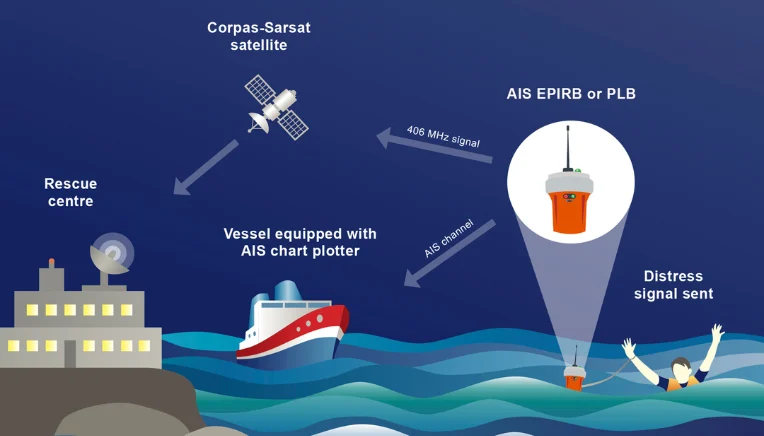There’s one piece of equipment on board that doesn’t need your hands, doesn’t ask for power, and doesn’t wait for orders. When all else fails, it silently sends a signal across the world that you need help. That’s your EPIRB – Emergency Position Indicating Radio Beacon.
Sadly, many cadets and even some junior officers only know it as a “box with antenna” stored somewhere on deck or inside the wheelhouse. But trust me, EPIRB is a silent hero of maritime safety.
Let’s understand this critical device the way seafarers should, with respect and awareness.
What is an EPIRB?
EPIRB is an emergency transmitter that sends distress signals to satellites when activated, either manually or automatically.
Its main job?
To alert search and rescue (SAR) authorities that your ship is in distress and to give them your position, identification, and GPS coordinates, even when all other systems are down.
In simple words: When the ship sinks or crew is lost at sea, the EPIRB says, “We are here. Help us.”
How Does It Work?
EPIRB transmits a 406 MHz signal to COSPAS-SARSAT satellites, which relay the message to nearest Rescue Coordination Centre (RCC).
Newer EPIRBs also send GPS position for faster response. Some models also transmit on 121.5 MHz, used for homing by aircraft or rescue boats.
Once activated, it:
Sends a distress alert
Gives your ship’s identity (MMSI or vessel name)
Sends GPS position (if built-in)
Repeats the signal every 50 seconds (usually)
Types of EPIRB
- Manual EPIRB : Must be activated by hand
- Float-free EPIRB : Automatically released by HRU when submerged
All SOLAS ships must carry a float-free EPIRB, correctly registered and tested.
Where Is It Located Onboard?
Usually:
On bridge wing, aft deck, or emergency muster area
Placed in a float-free bracket with HRU
Cadets and juniors must visually check it during rounds and know the location without hesitation.
What to Check During Routine Inspection
Every watchkeeping officer and cadet must be able to inspect an EPIRB properly.
Expiry date of battery and hydrostatic release unit (HRU)
Self-test function – Press test button (don’t hold too long)
Brackets and securing condition
Free float function – No obstruction
Registration label with ship details and country code
No cracks or corrosion on casing or antenna
Ensure it is not painted over or obstructed by gear
Important:
Never test it in real mode! If wrongly activated, notify the MRCC immediately to avoid false alarm and penalties.
What to Do in an Emergency
If abandoning ship, take EPIRB with you into lifeboat if possible
Once clear of vessel, activate it manually
Float it in water or tie it to raft – antenna must be upright and out of water
Let it transmit continuously – battery lasts around 48 hours
Questions They Ask in Orals or Drills
- What is an EPIRB and what is its function?
- What frequency does it transmit on?
- How is EPIRB activated automatically and manually?
- Where is EPIRB located on your vessel?
- What does COSPAS-SARSAT stand for?
- What is the validity of EPIRB battery and HRU?
- Can you test the EPIRB? How?
- What happens if EPIRB is accidentally activated?
Why Every Cadet & Junior Officer Must Know This
EPIRB is not just GMDSS equipment – it is your personal SOS.
If you don’t know how to use it, your chance of being found may reduce.
Understanding EPIRB also helps in ship inspections, MARPOL drills, and PSC questions.
As a future officer, your leadership in emergencies depends on your preparedness.
Final Thought – A Signal That Speaks for You
When your ship goes silent… when radios fail… when you are adrift in the vast sea — EPIRB keeps speaking.
So don’t treat it like just another box. Learn it. Respect it. Teach it to others.
Because in the worst moment, it may be the only thing calling for help…
while you float in silence, hoping someone hears.
Stay alert. Stay alive.


